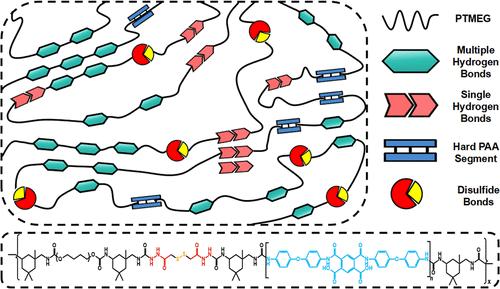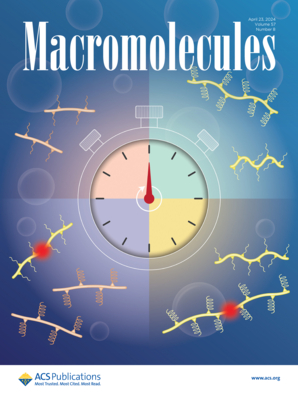High-Strength and Excellent Self-Healing Polyurethane Elastomer Based on Rigid Chain Segment Reinforcement
IF 5.1
1区 化学
Q1 POLYMER SCIENCE
引用次数: 0
Abstract
Owing to their extensive application scope, elastomers that combine high strength and excellent self-healing efficiency have always attracted significant attention and are still a contradiction. In this study, a novel PU elastomer was prepared by combining rigid poly(amic acid) (PAA) chain segments and 3,3-dithiodipropionic dihydrazide (DPH) containing sextuple hydrogen-bonding units and disulfide bonds. The prepared elastomer exhibited a high tensile strength of 50.1 MPa and a high toughness of 144.2 MJ/m3. The rigid PAA chain segments serve as a rigid framework, significantly enhancing the mechanical strength of the elastomer. Meanwhile, DPH with sextuple hydrogen-bonding units and disulfide bonds enabled the elastomer to exhibit an excellent self-healing efficiency of 96.1% after 12 h at 80 °C. Additionally, the strong and reversible cross-linking of the hydrogen-bonding arrays in the elastomer endows it with excellent mechanical strength, self-healing ability, and recyclability, allowing it to be recycled after hot pressing and dissolution.

求助全文
约1分钟内获得全文
求助全文
来源期刊

Macromolecules
工程技术-高分子科学
CiteScore
9.30
自引率
16.40%
发文量
942
审稿时长
2 months
期刊介绍:
Macromolecules publishes original, fundamental, and impactful research on all aspects of polymer science. Topics of interest include synthesis (e.g., controlled polymerizations, polymerization catalysis, post polymerization modification, new monomer structures and polymer architectures, and polymerization mechanisms/kinetics analysis); phase behavior, thermodynamics, dynamic, and ordering/disordering phenomena (e.g., self-assembly, gelation, crystallization, solution/melt/solid-state characteristics); structure and properties (e.g., mechanical and rheological properties, surface/interfacial characteristics, electronic and transport properties); new state of the art characterization (e.g., spectroscopy, scattering, microscopy, rheology), simulation (e.g., Monte Carlo, molecular dynamics, multi-scale/coarse-grained modeling), and theoretical methods. Renewable/sustainable polymers, polymer networks, responsive polymers, electro-, magneto- and opto-active macromolecules, inorganic polymers, charge-transporting polymers (ion-containing, semiconducting, and conducting), nanostructured polymers, and polymer composites are also of interest. Typical papers published in Macromolecules showcase important and innovative concepts, experimental methods/observations, and theoretical/computational approaches that demonstrate a fundamental advance in the understanding of polymers.
 求助内容:
求助内容: 应助结果提醒方式:
应助结果提醒方式:


